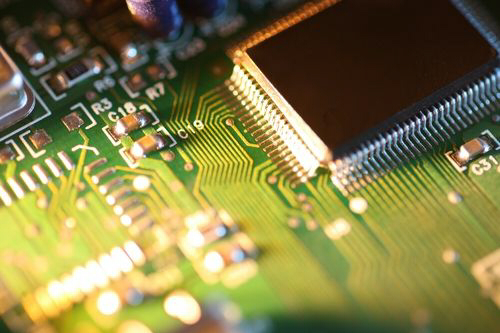After Moore’s Law: The Future of Computing
摩尔定律之后:计算的未来
The era of predictable improvement in computer hardware is ending. What comes next?
计算机硬件进步可预测的时代正在走向尾声。接下来是什么?
In 1971 the fastest car in the world was the Ferrari Daytona, capable of 280kph (174mph). The world’s tallest buildings were New York’s twin towers, at 415 metres (1,362 feet). In November that year Intel launched the first commercial microprocessor chip, the 4004, containing 2,300 tiny transistors, each the size of a red blood cell.
1971年,世界上最快的汽车是法拉利代托纳(Daytona),时速可达280公里。世界上最高的建筑物是纽约的双子塔,高415米。同年11月,英特尔推出了第一款商用微处理器芯片4004,由2300个微小的晶体管组成,每个有红血球大小。
Since then chips have improved in line with the prediction of Gordon Moore, Intel’s co-founder. According to his rule of thumb, known as Moore’s law, processing power doubles roughly every two years as smaller transistors are packed ever more tightly onto silicon wafers, boosting performance and reducing costs. A modern Intel Skylake processor contains around 1.75 billion transistors – half a million of them would fit on a single transistor from the 4004 – and collectively they deliver about 400,000 times as much computing muscle. This exponential progress is difficult to relate to the physical world. If cars and skyscrapers had improved at such rates since 1971, the fastest car would now be capable of a tenth of the speed of light; the tallest building would reach half way to the Moon.
从那以后芯片的进步与英特尔联合创始人高登·摩尔(Gordon Moore)的预测一致。根据他的经验法则,即摩尔定律,随着越来越小的晶体管被更紧密地封装到硅片上,性能提升、成本下降,芯片处理能力约每两年提升一倍。英特尔现在的Skylake处理器由约17.5亿个晶体管组成,4004芯片上一个晶体管的大小相当于50万个最新芯片上的晶体管,它们的整体运算能力是4004芯片的四十万倍。现实世界很难实现这样这样指数级的增长。如果自1971年起汽车和摩天大楼以这样的速度发展,那么现在最快的汽车速度已经能达到光速的十分之一;最高的建筑物再高一倍就要触到月球了。
The impact of Moore’s law is visible all around us. Today 3 billion people carry smartphones in their pockets: each one is more powerful than a room-sized supercomputer from the 1980s. Countless industries have been upended by digital disruption. Abundant computing power has even slowed nuclear tests, because atomic weapons are more easily tested using simulated explosions rather than real ones. Moore’s law has become a cultural trope: people inside and outside Silicon Valley expect technology to get better every year.
摩尔定律的影响在我们周围随处可见。今天30亿人口袋里装着智能手机:每个手机都比20世纪80年代房间大小的超级计算机能力更强。无数行业因数字化的剧变而被颠覆。强劲的计算能力甚至已经减少了核试验的次数,因为比起实际试验,原子武器更容易通过模拟爆炸测试。摩尔定律已成为一种文化指代:硅谷内外的人都期盼着技术每年有进步。
But now, after five decades, the end of Moore’s law is in sight. Making transistors smaller no longer guarantees that they will be cheaper or faster. This does not mean progress in computing will suddenly stall, but the nature of that progress is changing. Chips will still get better, but at a slower pace (number-crunching power is now doubling only every 2.5 years, says Intel). And the future of computing will be defined by improvements in three other areas, beyond raw hardware performance.
然而五十年后的现在,摩尔定律已走到了尽头。将晶体管做得更小不再能保证它们会更便宜或更快。这并不是说计算能力的提升会突然停滞,但是这种提升的本质正在改变。芯片还会更好,但提升的速度会放缓(英特尔称,运算能力目前要每两年半才翻一倍)。计算的未来将由其他三方面的进步定义,而不再只是单纯的硬件性能提升。

Faith no Moore
摩尔不再可信
The first is software. This week AlphaGo, a program which plays the ancient game of Go, beat Lee Sedol, one of the best human players, in the first two of five games scheduled in Seoul. Go is of particular interest to computer scientists because of its complexity: there are more possible board positions than there are particles in the universe. As a result, a Go-playing system cannot simply rely on computational brute force, provided by Moore’s law, to prevail. AlphaGo relies instead on “deep learning” technology, modelled partly on the way the human brain works. Its success this week shows that huge performance gains can be achieved through new algorithms. Indeed, slowing progress in hardware will provide stronger incentives to develop cleverer software.
首先是软件。本周一款围棋软件AlphaGo在首尔如期举行的五番棋比赛的头两盘中击败了人类最优秀的棋手之一李世石。由于围棋的复杂性,计算机科学家对它特别感兴趣:棋盘上落子位置的可能性比宇宙中的粒子数量还要多。因此,要取得胜利,围棋软件不能简单地依靠由摩尔定律提供的计算蛮力。相反,AlphaGo依靠的是“深度学习”技术,在一定程度上模仿人类大脑的工作方式。它本周的成功表明通过新的算法可以取得性能的巨大进步。实际上,硬件提升放缓将为开发更加智能的软件提供更强劲的推动力。
The second area of progress is in the “cloud”, the networks of data centres that deliver services over the internet. When computers were stand-alone devices, whether mainframes or desktop PCs, their performance depended above all on the speed of their processor chips. Today computers become more powerful without changes to their hardware. They can draw upon the vast (and flexible) number-crunching resources of the cloud when doing things like searching through e-mails or calculating the best route for a road trip. And interconnectedness adds to their capabilities: smartphone features such as satellite positioning, motion sensors and wireless-payment support now matter as much as processor speed.
第二个进步领域是“云”,即通过互联网提供服务的数据中心网络。当计算机是单机设备时,无论是大型主机还是台式电脑,它们的性能首先取决于处理器芯片的速度。今天的计算机无需改变硬件就能变得更为强大。它们可以利用云端庞大(且灵活)的运算资源来搜索电子邮件或者计算最佳出游路线。互联性增强了计算机的能力:智能手机的功能如卫星定位、运动传感器和无线支付等现在与处理器速度同等重要。
The third area of improvement lies in new computing architectures – specialised chips optimised for particular jobs, say, and even exotic techniques that exploit quantum-mechanical weirdness to crunch multiple data sets simultaneously. There was less need to pursue these sorts of approaches when generic microprocessors were improving so rapidly, but chips are now being designed specifically for cloud computing, neural-network processing, computer vision and other tasks. Such specialised hardware will be embedded in the cloud, to be called upon when needed. Once again, that suggests the raw performance of end-user devices matters less than it did, because the heavy lifting is done elsewhere.
第三个进步领域是新的计算架构,如为特殊工作优化的特制芯片,甚至利用量子力学这种新技术的超凡力量来同时处理多个数据集。当通用微处理器能快速提升运算速度时,不那么需要追求这些途径,但是现在的芯片特为云计算、神经网络处理、计算机视觉和其他任务而设计。这些专用硬件将被装在云端,需要时可以随时调用。这再一次表明终端用户设备自身的性能不如以前那么重要,因为繁重的工作已经在别处完成了。
Speed isn’t everything
速度并非所有
What will this mean in practice? Moore’s law was never a physical law, but a self-fulfilling prophecy – a triumph of central planning by which the technology industry co-ordinated and synchronised its actions. Its demise will make the rate of technological progress less predictable; there are likely to be bumps in the road as new performance-enhancing technologies arrive in fits and starts. But given that most people judge their computing devices on the availability of capabilities and features, rather than processing speed, it may not feel like much of a slowdown to consumers.
这在实际中意味着什么呢?摩尔定律绝非物理法则,而是自我应验的寓言,是科技行业齐心协力达成的集中规划的胜利。它的消亡会让技术进步的速度更难预测;提升性能的新技术的出现有早有晚,因此这条路可能会时起时落。但是考虑到大多数人依赖功能与特性的有无而非处理速度来评价他们的计算设备,消费者可能对发展减速感触不大。
For companies, the end of Moore’s law will be disguised by the shift to cloud computing. Already, firms are upgrading PCs less often, and have stopped operating their own e-mail servers. This model depends, however, on fast and reliable connectivity. That will strengthen demand for improvements to broadband infrastructure: those with poor connectivity will be less able to benefit as improvements in computing increasingly happen inside cloud providers’ data centres.
对公司而言,向云计算的转向将掩盖摩尔定律的终结。公司升级台式电脑的频率已经降低,也不再运营自己的邮件服务器。不过这一模式依赖的是快速可靠的连通性。这会加强对宽带基础设施提升的要求:随着云提供商的数据中心内部计算能力的不断提升,连通性差的公司将越来越无法从中受益。
For the technology industry itself, the decline of Moore’s law strengthens the logic for centralised cloud computing, already dominated by a few big firms: Amazon, Google, Microsoft, Alibaba, Baidu and Tencent. They are working hard to improve the performance of their cloud infrastructure. And they are hunting for startups touting new tricks: Google bought Deepmind, the British firm that built AlphaGo, in 2014.
对于科技行业自身而言,摩尔定律的衰落强化了集中式云计算的逻辑,这已经由少数几家大公司主导:亚马逊、谷歌、微软、阿里巴巴、百度和腾讯。它们正努力提升自己云基础设施的性能,同时也在搜罗别具创意的创业公司:谷歌2014年收购了Deepmind,正是这家英国公司开发了AlphaGo。
For more than 50 years, the seemingly inexorable shrinking of transistors made computers steadily cheaper and more capable. As Moore’s law fades, progress will be less metronomic. But computers and other devices will continue to become more powerful – just in different and more varied ways.
半个多世纪以来,晶体管不断缩小,看似无可阻挡,让计算机价格稳步降低、性能持续提升。随着摩尔定律的消亡,进步不再那么有时间规律。但计算机和其他设备会不断变得更强大,只是以不同的、更多元化的方式。
下载:英文、中文版本








